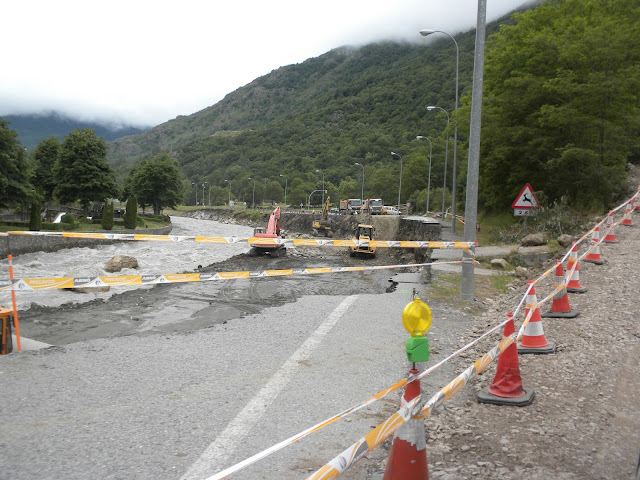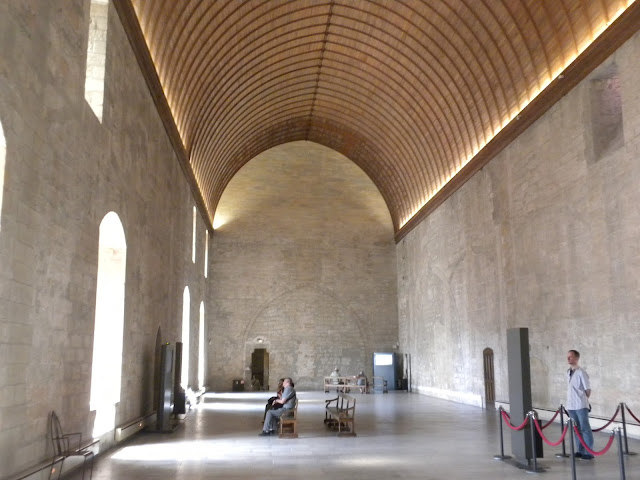“Peculiar travel suggestions are
dancing lessons from God.” Kurt
Vonnegut (Cat’s Cradle)
Carol
writes: We could not pass up the
opportunity to take a brief turn south and take in some sightseeing in the
Pyrenees Mountains before we headed up the center of France toward the Normandy
coast. Our intention is to leave France
at Calais for the ferry crossing across the English Channel to Dover, England, in
mid-July. Then, after spending the rest
of the summer and early fall in the UK, our general plan is to winter over in
Spain and Portugal, where we hope the milder winter temperatures will be more
favorable for camping. So…in late fall,
we will head to Spain by hugging the French Atlantic coast and avoiding at all
cost any snowy roads near the mountainous Pyrenees border area. Thus…it is now or never for a chance to drive
through the Pyrenees Mountains.
Having lived
at the foot of the Rocky Mountains in Colorado Springs for the past 23 years,
we are used to splendid mountain scenery; however, we had one of those perfect
sunny days on our ride into the Pyrenees that left us awe-struck at their
beauty.
Patches of
snow still clung to high depressions, and countless engorged waterfalls from
the snow melt graced the steep ravines. At
a spectacularly beautiful stop, we traded conversation and mutual
picture-taking with a group of three very friendly German motorcyclists who
were on a 2-week motorbike adventure.
A few miles
further we crossed the border and entered the tiny principality of Andorra, known only
to us as one of the first countries (after Greece) that marches into the Olympic
stadium with their very tiny contingent of athletes at every Winter
Olympics.
The incredible
mountain beauty of Andorra with its very modern ski communities was immediately
apparent to us.
In a mere couple
of hours we had travelled along the main highway through Andorra and had crossed
over the international border into Spain.
Time to get acquainted with road signs and handy informational signage
in another language…
Incredible
Catalonian scenery was all around us…
We camped
for the night in our first Spanish campground and found it very relaxing and
less hung up on regulations than the French ones. The pool area here had no annoying fences,
gates, or obligatory nasty foot washes—just a natural setting with a pool
surrounded by grass and several families with kids having a good time. Showers had all the HOT water you could
want—without having to push a button every 20-30 seconds in order to keep the
water flowing. Spain was starting to
grow on me…
At check-in,
our young campground hostess had given us a brochure on a nearby Spanish national
park that had impressive pictures of some pretty high peaks. Our plan for the next morning was to take a
drive into the park, perhaps hike a short while and take in what looked to us
like magnificent scenery. Our hostess
told us it would be no problem taking our RV into the park. After being turned back by width limitations
on a narrow road leading into the park, we quickly aborted our plans to see the
park. In any case, we saw some mighty fine
scenery of the edge of the park as we proceeded along our way.
As we headed
north to reenter France, we travelled through several small towns that had very
recently experienced a terrible flood event.
Parts of the road were washed out and lots of riverbank infrastructure
had taken a huge hit. In some places houses
and businesses were partially destroyed.
Meanwhile,
the river culprit continued to rush along the side of the road in an angry and
furious torrent of cloudy gray water, still clearly out of its banks.
After an
hour’s detour due to a washed-out road, we were back in France heading north
and stopped for the night in Lourdes, where we found out the flood was quite
widespread and had occurred only 4 days ago.
We were amazed at the very quick response by French work crews who were totally
immersed in repair work along our route.
LOURDES,
FRANCE: Having attended Catholic grade
school, I was well acquainted with the pilgrimage site of Lourdes and had
always wondered what it would be like to visit such sacred ground. Tiny Lourdes stamped its way onto the world
map in 1858 when a young peasant girl by the name of Bernadette Soubirous
reported having visions of the Blessed Virgin Mary in a cave-like entrance
along the Pau River. Over the course of
18 separate visions, Bernadette claimed that the Blessed Mother told her she wished
to have a church built on that spot.
Fast forward a century and a half…above the grotto visitation site there
are now two splendid cathedrals, one of them partially underground.
The
half-mile or so walk to the sanctuary site was lined with somewhat tacky and
garish tourist shops that sold every kind of religious statue or trinket that
you could imagine. But, a rosary
palace???
For me, this
wasn’t quite what the Virgin Mary had in mind; nevertheless, it is a fact that
religious sales serve a purpose for some and are big business. OK, I confess that I did purchase an empty
holy water vial in one of the shops so I could fill it with some Lourdes holy
water for myself.
A reliquary
of St. Bernadette Soubirous was located in a little side niche outside the cathedral.
The natural
spring waters that flow through this holy grotto site are said to have
miraculous healing powers. The custom is
to fill your water vials and containers with some of the holy water and either
drink it or use it in whatever manner you wish.
The
visitation grotto…
Despite all
the crass commercialism leading up to the visitation grotto, once we reached
the most sacred area, there was a feeling of something special there. Mass was just finishing up when we arrived at
the grotto and so I quickly joined the line of people who were vacating the
pews and heading directly into the very small grotto. We saw nuns, priests, and pilgrims (many of
them in wheelchairs) of many nationalities.
Their reverence and unshakable faith and belief in what had occurred
there was quite solemn and personal. It
was not hard to get caught up in the moment, and I was glad that we had decided
to visit Lourdes.
"Please go
to the priests and tell them that a chapel is to be built here. Let processions
come hither." Words of the Blessed
Virgin Mary to Bernadette Soubirous in 1858













































































